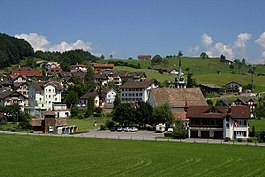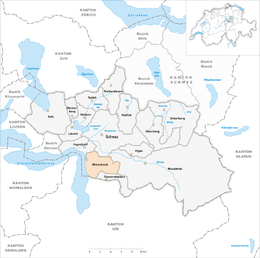Morschach
| Morschach | ||
|---|---|---|
 |
||
|
||
| Coordinates: 46°58′N 8°37′E / 46.967°N 8.617°ECoordinates: 46°58′N 8°37′E / 46.967°N 8.617°E | ||
| Country | Switzerland | |
| Canton | Schwyz | |
| District | Schwyz | |
| Area | ||
| • Total | 20.81 km2 (8.03 sq mi) | |
| Elevation | 650 m (2,130 ft) | |
| Population (Dec 2015) | ||
| • Total | 1,124 | |
| • Density | 54/km2 (140/sq mi) | |
| Postal code | 6443 | |
| SFOS number | 1366 | |
| Surrounded by | Ingenbohl, Muotathal, Riemenstalden, Seelisberg (UR), Sisikon (UR), Schwyz | |
| Website |
www SFSO statistics |
|
Morschach is a municipality in Schwyz District in the canton of Schwyz in Switzerland.
Morschach is first mentioned in 1261 as Morsacho.
Morschach has an area, as of 2006[update], of 20.8 km2 (8.0 sq mi). Of this area, 52.3% is used for agricultural purposes, while 36.2% is forested. Of the rest of the land, 2.9% is settled (buildings or roads) and the remainder (8.6%) is non-productive (rivers, glaciers or mountains).
The municipality is located on a glacier moraine above the Lake of Lucerne. It consists of the village of Morschach and includes the summer and winter sport center at Stoos.
Morschach has a population (as of 31 December 2015) of 1,124. As of 2007[update], 14.7% of the population was made up of foreign nationals. Over the last 10 years the population has grown at a rate of 9.3%. Most of the population (as of 2000[update]) speaks German (89.0%), with Serbo-Croatian being second most common ( 2.0%) and Portuguese being third ( 1.7%).
As of 2000[update] the gender distribution of the population was 54.4% male and 45.6% female. The age distribution, as of 2008[update], in Morschach is; 274 people or 28.6% of the population is between 0 and 19. 331 people or 34.6% are 20 to 39, and 247 people or 25.8% are 40 to 64. The senior population distribution is 67 people or 7.0% are 65 to 74. There are 36 people or 3.8% who are 70 to 79 and 3 people or 0.31% of the population who are over 80.
As of 2000[update] there are 305 households, of which 75 households (or about 24.6%) contain only a single individual. 27 or about 8.9% are large households, with at least five members.
...
Wikipedia



